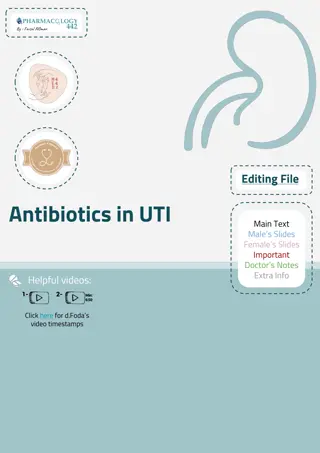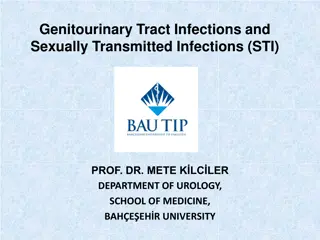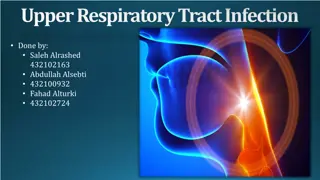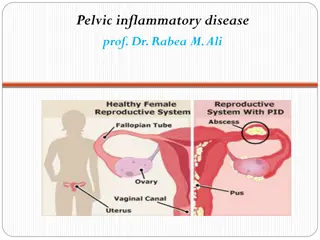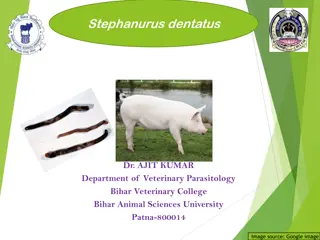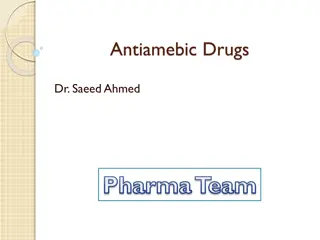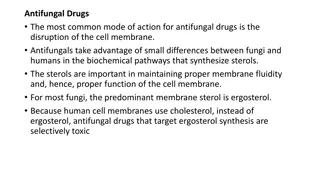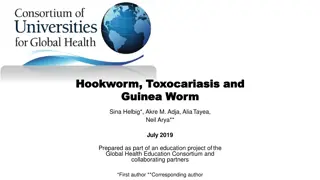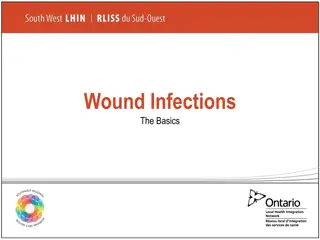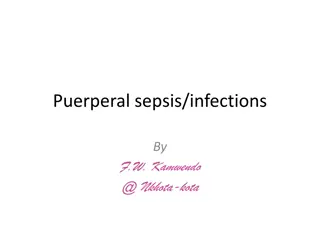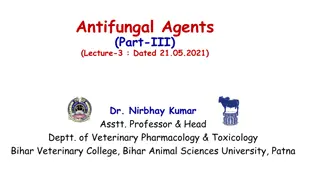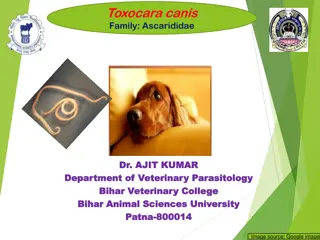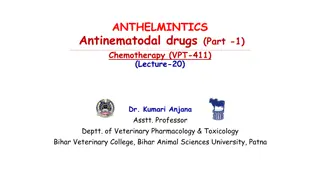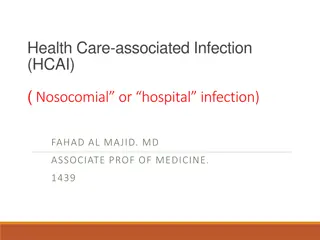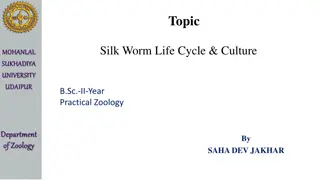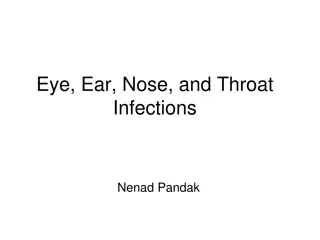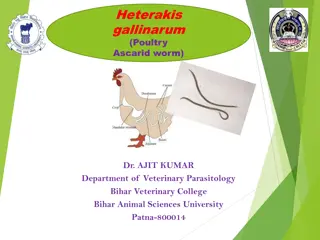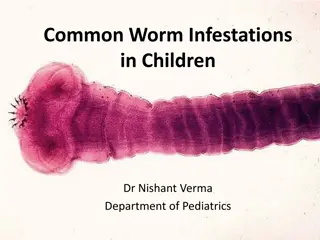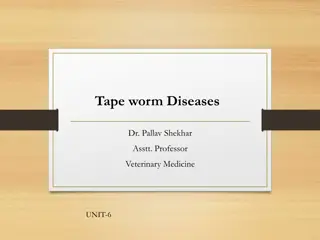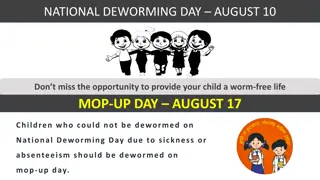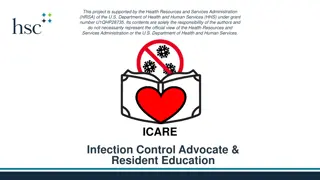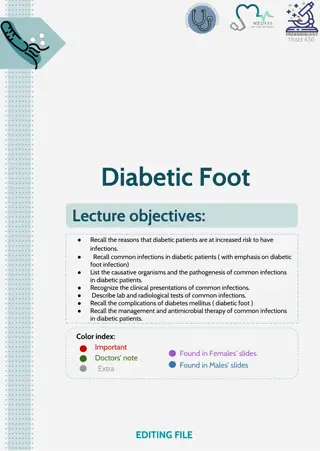Understanding Anaemia and Infections in Relation to Health
Anaemia can result from various causes such as blood loss, increased destruction of red blood cells, and impaired production, often linked to infections and chronic diseases. Parasites, bacteria, and viruses play a role in the progression of anaemia, affecting the body's ability to produce and utili
3 views • 10 slides
Understanding Nontuberculous Mycobacteria Infections in Cystic Fibrosis
Nontuberculous mycobacteria (NTM) infections present a significant challenge in individuals with cystic fibrosis (CF). These infections are caused by over 200 species of atypical mycobacteria found in various environments. The CF-ID Clinic plays a crucial role in managing patients with multi-drug re
2 views • 25 slides
Estimation of Serious Mycoses Burden in Indonesia
This study estimates the burden of serious fungal infections in Indonesia, a country with rich biodiversity and limited medical mycology facilities. The data indicates a high prevalence of opportunistic infections in AIDS patients and TB cases, with Candidiasis and Cryptococcosis being significant c
2 views • 29 slides
Understanding Urinary Tract Infections (UTIs) and Antibiotics: A Comprehensive Overview
Urinary Tract Infections (UTIs) are a common issue, more prevalent in women, with causes ranging from poor hygiene to underlying health conditions. The content delves into the classification of UTIs, their main causes, and bacteria responsible for infections. It also covers the complications of UTIs
0 views • 12 slides
Anaerobic Bacterial Infections: Overview and Clinical Implications
Anaerobic bacterial infections are caused by bacteria that do not require oxygen for growth, posing challenges in diagnosis and treatment. This article delves into the types of anaerobic bacteria, their role in human infections, and common clinical presentations such as abscess formation. Gram-negat
2 views • 24 slides
Elevate Performance with Parkash Industrial Gears' Precision Worm Gear Manufactu
Parkash Industrial Gears excels in worm gear manufacturing, offering precision-engineered solutions for diverse industrial applications. With decades of expertise and cutting-edge technology, we ensure the highest standards of quality and accuracy in every gear produced. Our dedication to excellence
5 views • 7 slides
Overview of Genitourinary Tract Infections and STIs by Prof. Dr. Mete Kılcıler
Genitourinary Tract Infections and Sexually Transmitted Infections (STIs) are common conditions affecting both men and women. This article, presented by Prof. Dr. Mete Kılcıler from the Department of Urology at Bahçeşehir University School of Medicine, delves into the various aspects of UTIs, in
2 views • 47 slides
Worm Gear Manufacturing Unveiled: Driving Industries Forward with Precision
Explore the intricate world of gear manufacturing with our comprehensive guide. From the precision of worm gear manufacturing to the efficiency of helical gears and the versatility of bevel gears, discover how these components drive industries forwar
1 views • 8 slides
Differentiating between Viral and Bacterial Infections in Upper Respiratory Tract
Understanding the distinction between viral and bacterial upper respiratory tract infections is crucial for effective management and treatment. This article discusses key differences in symptoms, diagnostic methods, and treatment approaches to aid in accurate differentiation between the two types of
2 views • 87 slides
Understanding Fungi Diversity and Infections in Microbiology
Explore the world of fungi and fungal infections in this foundation block of microbiology. Learn about medically important yeasts, mold fungi, major fungal diseases, antifungal agents, and infection acquisition methods. Dive into hypersensitivity reactions, mycotoxicoses, and various types of fungal
1 views • 19 slides
Understanding Female Reproductive Infections and Inflammations
Female reproductive system infections such as Pelvic Inflammatory Disease (PID), Vaginitis, Cervicitis, Endometritis, and Salpingitis can lead to various symptoms and complications. These conditions are caused by different factors including infections, bacterial imbalances, and sexually transmitted
0 views • 44 slides
Understanding Stephanurus Dentatus: Kidney Worm of Pigs
Stephanurus dentatus is a parasitic worm that infects pigs, with an intricate life cycle involving earthworms as transport hosts. Transmission occurs through ingestion of larvae or infected earthworms, leading to various pathological effects, including subcutaneous nodules, cirrhosis, and organ dama
0 views • 13 slides
Understanding Virus-Cell Interactions and Infections
Viral infections exhibit diverse cellular tropism based on receptor interactions, impacting cell function through modulation and potential host defense responses. Infections can lead to various outcomes, from cell death to persistent or latent states, with nuanced effects on cellular behavior. Diffe
0 views • 8 slides
Understanding Antiamebic Drugs: A Guide to Managing Protozoal Infections
Protozoal infections, such as amebiasis, are a significant concern globally. In underdeveloped regions and beyond, these infections pose challenges due to inadequate sanitation and hygiene practices. Antiamebic drugs are essential for treating conditions like amebiasis, caused by Entamoeba histolyti
0 views • 40 slides
Understanding Antifungal Drugs: Modes of Action and Applications
Antifungal drugs target ergosterol biosynthesis in fungi, disrupting cell membrane integrity. Imidazoles like miconazole and ketoconazole are commonly used for skin infections, while triazoles such as fluconazole treat systemic yeast infections. Allylamines inhibit ergosterol synthesis, with terbina
0 views • 13 slides
Overview of Hookworm, Toxocariasis, and Guinea Worm Infections
These infections are significant global health issues affecting millions of individuals worldwide. Hookworm infection, a leading cause of iron-deficiency anemia, is prevalent in tropical and sub-tropical regions. Risk factors include poor sanitation and walking barefoot on contaminated soil. The bio
0 views • 46 slides
Understanding Wound Infections: A Comprehensive Overview
Explore the various stages of wound infections on a continuum from contamination to systemic infection. Learn how to identify and manage each stage, from presence of microbes to invasion of surrounding tissues. Discover the subtle signs of local and spreading infections, and the serious implications
1 views • 30 slides
Prevention and Management of Puerperal Sepsis and Infections
Puerperal sepsis and infections are serious conditions affecting women postpartum. Puerperal sepsis is characterized by specific symptoms, while puerperal infections are more general. Prevention includes antenatal care, strict intrapartum hygiene practices, and timely interventions. By following gui
2 views • 8 slides
Understanding Anthelmintics: Drug Therapy for Parasitic Worm Infections in Veterinary Medicine
Anthelmintics are essential drugs to combat parasitic worm infections in animals. They work either by killing (vermicide) or expelling (vermifuge) the worms, reducing worm burdens and controlling infections. This comprehensive overview covers different aspects of anthelmintics, including their prope
2 views • 34 slides
Understanding Azole Antifungal Agents for Veterinary Use
Azole antifungal agents play a crucial role in treating fungal infections in veterinary medicine. Imidazoles like clotrimazole and triazoles like fluconazole are commonly used for their fungistatic properties. These agents inhibit fungal enzymes, disrupting membrane fluidity and inhibiting cell repl
0 views • 14 slides
Understanding the Treatment of Respiratory Tract Infections: Antibiotics and Management
This lecture covers the classification of respiratory tract infections and the antibiotics commonly used to treat them. It highlights the types of infections caused by viruses and bacteria, along with their respective treatments. The mechanism of action and pharmacokinetics of antibiotics, such as p
0 views • 7 slides
Comprehensive Overview of Toxocara canis Life Cycle and Characteristics
Toxocara canis, also known as the Arrow-headed worm, is a parasite commonly found in dogs, particularly in puppies less than six months old. This article explores the general characteristics, life cycle, transmission routes, and prenatal infections of Toxocara canis. From the appearance of the male
0 views • 12 slides
Understanding Anthelmintics in Veterinary Pharmacology
This lecture by Dr. Kumari Anjana covers anthelmintic drugs used in veterinary medicine, focusing on the classification of simple heterocyclic compounds, benzimidazoles, and their prodrugs. It discusses the spectrum, mechanism of action, administration, contraindications, and uses of piperazine and
0 views • 27 slides
Understanding Trichostrongyle Transmission and Strategic Control
Trichostrongyle transmission primarily occurs through pasture contamination with eggs shed by adult worm populations in grazing hosts. The development of infective larvae on pasture involves specific conditions like moisture and warmth, leading to different types of ostertagiasis infections. Various
0 views • 20 slides
Important Information on National Deworming Day
Educational outcomes, cognitive development, nutritional uptake, and physical growth are crucial for a child's well-being. Protect your child from worm infestation by following preventive measures such as keeping surroundings clean and ensuring deworming on National Deworming Day. Worm infestations
0 views • 14 slides
Understanding Health Care-associated Infections (HCAI) in Hospital Settings
Health care-associated infections (HCAI), also known as nosocomial or hospital infections, are infections that occur in patients during their hospital stay or after discharge. These infections can result from various sources, including colonization by microorganisms and exposure to contaminated envi
0 views • 48 slides
Silk Worm Life Cycle and Culture at Mohanlal Sukhadiya University Udaipur
The life cycle of silk worms, particularly Bombyx mori, is detailed in this practical study conducted by the Department of Zoology at Mohanlal Sukhadiya University, Udaipur. The process from eggs to larvae, cocoon formation, and the emergence of the adult silk moth is explained. Silk worms feed on m
0 views • 13 slides
Overview of Eye, Ear, Nose, and Throat Infections by Nenad Pandak
In this comprehensive guide by Nenad Pandak, various aspects of eye, ear, nose, and throat infections are discussed. The content covers infections such as conjunctivitis, keratitis, pharyngitis, otitis media, and sinusitis. It also delves into causes, clinical presentations, and diagnosis of these i
0 views • 68 slides
Understanding Respiratory Tract Infections: Causes and Prevention
Respiratory tract infections are commonly caused by viruses, bacteria, rickettsia, and fungi, leading to various health issues. These infections can be transmitted through droplets, droplet nuclei, and dust, emphasizing the importance of maintaining respiratory health through specific and non-specif
0 views • 34 slides
Understanding Viral Infections of the Respiratory System
Respiratory viral infections are common and primarily caused by viruses, leading to morbidity and time off work. They can range from mild upper respiratory tract infections to severe lower respiratory tract infections like pneumonia. Various viruses like influenza, parainfluenza, respiratory syncyti
0 views • 23 slides
Understanding Cestoda: The Tapeworms in Platyhelminthes
Cestoda, a class of parasitic flatworms in the phylum Platyhelminthes, have a unique body structure with a scolex, neck, and segmented strobila. These tapeworms lack a digestive tract, absorbing nutrients through their body. They are hermaphrodites, with male and female reproductive organs in the sa
0 views • 12 slides
Understanding Heterakis Gallinarum: Poultry Ascarid Worm
Heterakis gallinarum, a caecal worm found in domestic and wild birds, plays a role in transmitting Histomonas meleagridis, causing diseases like blackhead in turkeys. Clinical signs include anaemia, diarrhoea, and emaciation. Diagnosis involves microscopic examination, and treatment with fenbendazol
0 views • 10 slides
Learn the Break-Dancing Move - Kick-Worm or Caterpillar!
Explore the iconic break-dancing move known as the kick-worm or caterpillar, its history, and popularity. Discover how to perform this dance skill at events like parties, weddings, and more. The step-by-step instructions and muscle engagement guide will help you master this dynamic movement.
0 views • 19 slides
Overview of Common Worm Infestations in Children and Neglected Tropical Diseases (NTDs)
Common worm infestations in children, such as Ascaris lumbricoides and Enterobius vermicularis, are a significant health concern globally. Neglected Tropical Diseases (NTDs) like ascariasis, hookworm, and lymphatic filariasis affect millions of people, particularly those in poverty. For just 50 cent
0 views • 25 slides
Understanding Tape Worm Diseases in Veterinary Medicine
Tape worm diseases, such as cysticercosis and coenurosis, affect various animals like sheep, cattle, horses, dogs, and cats. The pathogenesis involves indirect mechanisms, leading to larval stages like metacestodes. Heavy infections can result in colic, diarrhea, and anemia in animals. Diagnosis inv
0 views • 14 slides
National Deworming Day - August 10: Ensure Your Child's Health
National Deworming Day on August 10 aims to provide children with a worm-free life. Don't miss the opportunity to deworm your child and promote their well-being. The event emphasizes the importance of deworming for physical and cognitive development. Albendazole, a safe and beneficial treatment, wil
0 views • 9 slides
Understanding Common Infections in Nursing Home Residents
Explore the causes, types, and impact of infections in nursing home residents while learning how to prevent and control infections. Discover common infections, factors contributing to infections, and resident rights in infection control practices.
0 views • 23 slides
Understanding Diabetic Foot Infections and Associated Risks
Diabetic patients are prone to infections, significantly impacting morbidity and mortality rates. Increased infection risk is due to both host-related and organism-related factors. Common infections in diabetic patients include skin and soft tissue infections, diabetic foot infections, respiratory t
0 views • 14 slides
Preventing Catheter-Associated Urinary Tract Infections
This presentation covers the prevention of catheter-associated urinary tract infections (CAUTIs) in healthcare settings. It highlights the significance of urinary tract infections, risk factors, preventive measures, and common microbiology involved. Key topics include the importance of urine collect
0 views • 34 slides
Managing Catheter-Related Bloodstream Infections in Vascular Access
Reduce and prevent catheter-related bloodstream infections in vascular access by addressing extraluminal infection sources and implementing strategies outlined in national drivers such as the NHS Long Term Plan and the Antimicrobial Resistance Action Plan. Recognize the importance of tackling antimi
0 views • 25 slides



